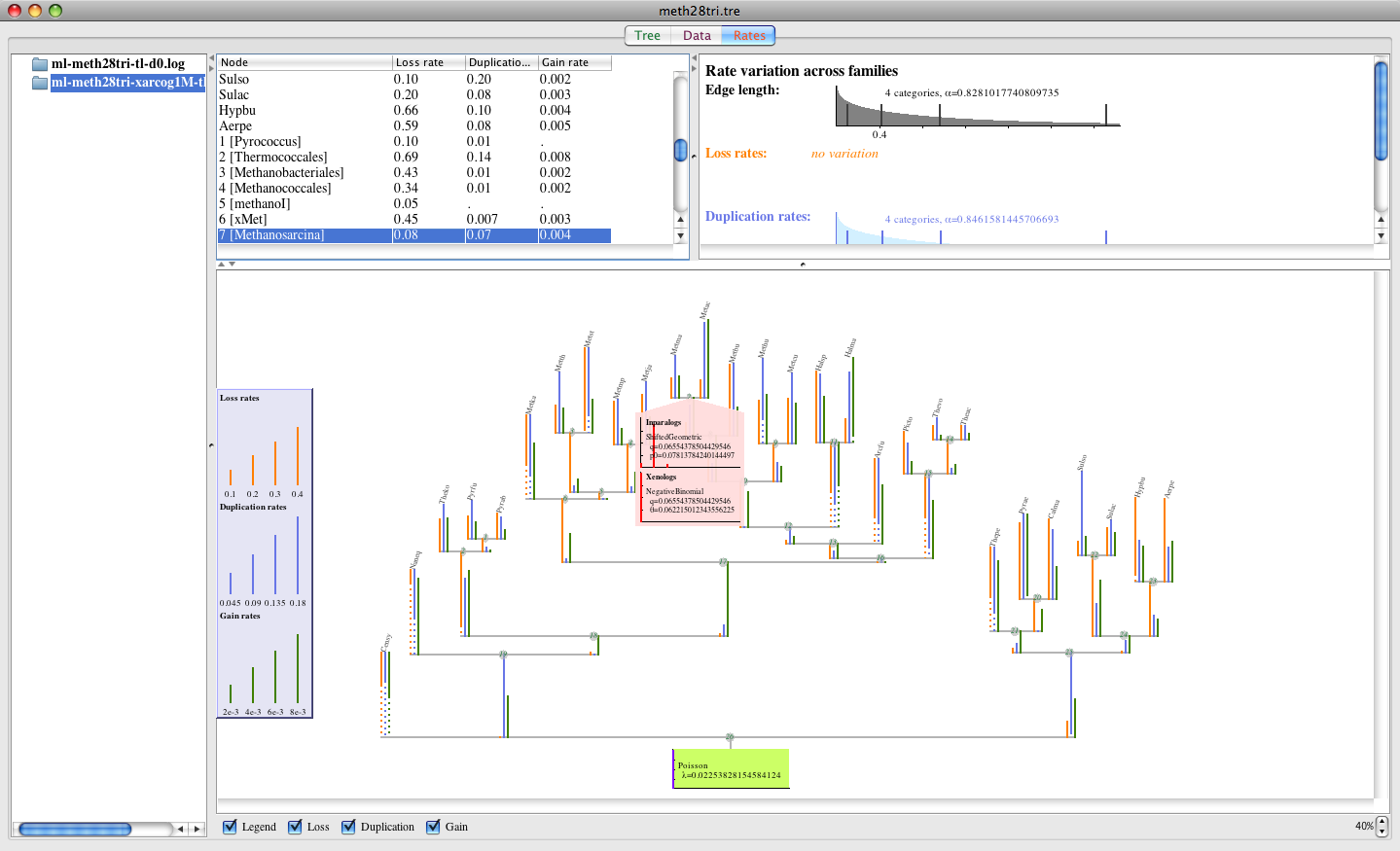Intro
Count is a software package for the evolutionary analysis of homolog family sizes (phylogenetic profiles), or other numerical census-type characters along a phylogeny. The principal data consist of the distribution of homolog family sizes across multiple genomes: for each (gene) family, that table gives the number of homologs identified in each genome. Count has been tested using data from the arCOG and KOG databases. The implemented tasks include the following.
- Family filtering by family size, presence in selected genomes, or other criteria.
- Parameter optimization for a phylogenetic birth-and-death model.
- Ancestral reconstruction by Dollo parsimony.
- Ancestral reconstruction by symmetric or asymmetric Wagner parsimony.
- Ancestral reconstruction by posterior probabilities in a phylogenetic birth-and-death model.
Availability
Count is written entirely in Java, and, thus, can be used in different operating systems, including Mac OS X, Microsoft Windows, and various Unix/Linux versions. The software is packaged in a JAR file, and can be executed in Java versions 1.6 and above, on a 64-bit Java VM. The distributed platform-specific packages, described below, include the JAR file with the necessary bundling for execution, as well as the User's Guide and a test directory.
Downloadable files
- count-usage.pdf: User's Guide
- Count.jar: JAR package
- Count.dmg: MacOS disk image
- Count.zip: Microsoft Windows package
- Count.tgz: Unix/Linux package
- test.tar.gz: test data
Mac OS X
I have written the software using a Mac, and went to some extent to integrate the Java executable into a native-looking application. The JAR file is bundled as Count.app, which you can just run directly by double-clicking on it. Please note that the application attempts to set the memory usage for the Java Virtual Machine by enabling a minimum of 1000 Megabytes and a maximum of 4000 Megabytes for the heap size. If your computer does not have that much memory, the application may not function properly. One solution is to follow the instructions for Unix/Linux below, and launch Count from a Terminal window. Alternatively, you can send me an e-mail and I will gladly prepare a small-memory version of the application for you.
Installation: Download the disk image Count.dmg, open it, and place the application Count.app into an appropriate directory. For convenience, you may want to copy it to the Applications folder, either at the system level, or in your own home directory.
Microsoft Windows
You need to have a 64-bit Java Virtual Machine on your computer in order to run Count. You could download, for instance, Sun's Java Runtime Environment from http://www.java.com/, which is the JRE I used in the testing. You can launch Count via the provided MS-DOS batch file that sets the heap space for the JVM to 1000 Megabytes. Edit the batch file manually, if necessary for using more memory.
Installation: Download the ZIP file Count.zip. The archive contains the class hierarchy, test files, the documentation and the batch file Count.bat.
Unix/Linux
You can launch Count from the command line, by the command java -jar Count.jar. You will probably need to enable larger memory usage for the JVM than the default setting, which you can do by launching Count as java -Xmx1024M -jar Count.jar. The -Xmx option here sets the Java heap space to 1 Gigabytes: you can experiment with other settings appropriate for your computer and data set.
Installation: Download the gzipped TAR file Count.tgz into an appropriate directory. You can extract the files from the archive with the command tar zxf Count.tgz.
Java Webstart
The application can be launched directly through Java Webstart from a browser: count.jnlp
User's Guide
The User's Guide is available in PDF format as count-usage.pdf. Relevant information is available also through the Help menu of the software package.
Source code
I am happy to send you the source code if you are interested: send me an e-mail.
Licensing
Count is distributed under the terms of a BSD-style license, as shown below
Copyright © 2009, 2010 Miklós Csűrös
All rights reserved. Redistribution and use in source and binary forms, with or without modification, are permitted provided that the following conditions are met:
- Redistributions of source code must retain the above copyright notice, this list of conditions and the following disclaimer.
- Redistributions in binary form must reproduce the above copyright notice, this list of conditions and the following disclaimer in the documentation and/or other materials provided with the distribution.
- Neither the name of the Université de Montréal nor the names of its contributors may be used to endorse or promote products derived from this software without specific prior written permission.
THIS SOFTWARE IS PROVIDED BY THE COPYRIGHT HOLDERS AND CONTRIBUTORS
AS ISAND ANY EXPRESS OR IMPLIED WARRANTIES, INCLUDING, BUT NOT LIMITED TO, THE IMPLIED WARRANTIES OF MERCHANTABILITY AND FITNESS FOR A PARTICULAR PURPOSE ARE DISCLAIMED. IN NO EVENT SHALL THE COPYRIGHT OWNER OR CONTRIBUTORS BE LIABLE FOR ANY DIRECT, INDIRECT, INCIDENTAL, SPECIAL, EXEMPLARY, OR CONSEQUENTIAL DAMAGES (INCLUDING, BUT NOT LIMITED TO, PROCUREMENT OF SUBSTITUTE GOODS OR SERVICES; LOSS OF USE, DATA, OR PROFITS; OR BUSINESS INTERRUPTION) HOWEVER CAUSED AND ON ANY THEORY OF LIABILITY, WHETHER IN CONTRACT, STRICT LIABILITY, OR TORT (INCLUDING NEGLIGENCE OR OTHERWISE) ARISING IN ANY WAY OUT OF THE USE OF THIS SOFTWARE, EVEN IF ADVISED OF THE POSSIBILITY OF SUCH DAMAGE.
I would be very grateful if you could send me a note in case you decide to use Count. (Aside from making me happy, you'd have my promise of notifying you about future updates.)


